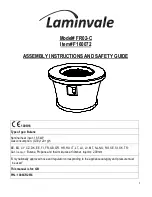
Page 23
8 - If the appliance will not operate, follow the instruc-
tions turning off gas to unit and call a service techni-
cian or gas supplier.
TURNING OFF GAS TO UNIT
1 - Turn OFF the burner switch (if applicable), or set the
thermostat to the lowest setting (if applicable).
2 - Turn off all electrical power to appliance.
3 - Turn OFF gas supply at main manual shut-off valve lo-
cated near the fireplace.
Adjustments
NOTE - The air shutter for the burner primary air opening
is factory-set. Do not adjust the factory-set position.
GAS FLOW
This burner / log set has been adjusted for the proper gas
flow at the factory. No adjustment is necessary other than
the pilot flame. See pilot flame adjustment section.
GAS PRESSURE
Check gas inlet pressure with the appliance firing at the
maximum rate. A minimum of 4.5 in. w.c. (1.12 kPa) and
maximum of 7.0 in. w.c. (1.74 kPa) for natural gas should
be maintained. When LP/Propane gas is used, a mini-
mum of 11.0 in. w.c. (2.74 kPa) and a maximum of 13.0 in.
w.c. (3.23 kPa) must be maintained.
Maximum manifold pressure is 3.5 in. w.c. (0.87 kPa) for
natural gas and 10 in. w.c. (2.49 kPa) for LP/Propane gas.
HIGH ALTITUDE INSTALLATION
Installations in the USA -
Units are tested and approved for elevations of 0-2000
feet (0-610 meters).
When installing this unit at an elevation above 2000 feet
(610 meters), decrease the input rate by changing the ex-
isting burner orifice to a smaller size. Input rate should be
reduced 4 percent for each 1000 feet (305 meters) of
elevation above sea level. For assistance in determining
the proper orifice size, check with the local gas utility or
consult the latest edition of the National Fuel Gas Code
(ANSI Z223.1, appendix F).
Installations in Canada -
Units are tested and approved for elevations of 0-4500
feet (0-1372 meters).
When installing this unit at an elevation above 4500
feet (1372 meters), consult the local authorities having
jurisdiction.
ELECTRICAL
NOTE - These checks are necessary only if optional blow-
er kit has been applied.
1 - Check all wiring for loose connections.
2 - Check for correct voltage at unit (unit operating).
PILOT FLAME ADJUSTMENT
A - Millivolt System
To ensure proper gas valve operation, the pilot flame
should impinge upon both the thermopile and the low
mass thermocouple. See figure 35. The pilot flame ad-
justment screw is shown in figure 33.
PILOT FLAME - (Millivolt systems)
PIEZO IGNITOR
PILOT
NOTE - Flame must
impinge upon both
thermopile and low
mass thermocouple
to insure proper ap-
pliance operation.
THERMOPILE
LOW MASS
THERMOCOUPLE
FIGURE 35
B - Electronic Ignition System
To ensure proper gas valve operation, the pilot flame
should impinge upon the flame sensor. See figure 36. The
pilot flame adjustment screw is shown in figure 34.
PILOT FLAME - (Electronic Ignition systems)
IGNITOR
PILOT
FlAME SENSOR
NOTE - Flame must impinge
upon flame sensor to insure
proper appliance operation.
FIGURE 36
BURNER FLAME ADJUSTMENT
The burner flame may be adjusted by turning the HI/LO
knob on the gas valve to obtain the required heating out-
put and flame appearance. See figure 33 or 34. The burn-
er flame should be inspected at the beginning of each
heating season and burners should be cleaned by a quali-
fied service technician. The flame color will stabilize after
15 minutes of operation.
FAILURE TO OPERATE
If unit fails to operate check the following:
1 - Is thermostat calling for heat, if applicable?
2 - Is ON/OFF wall switch in ON position, if applicable?
3 - Is pilot lit, if applicable?
4 - Is gas turned ON at meter?
5 - Is gas valve in ON position (millivolt units)?
6 - Is gas turned ON at the appliance shut-off valve?
7 - Is electrical power turned ON to the appliance (if
applicable)?




































